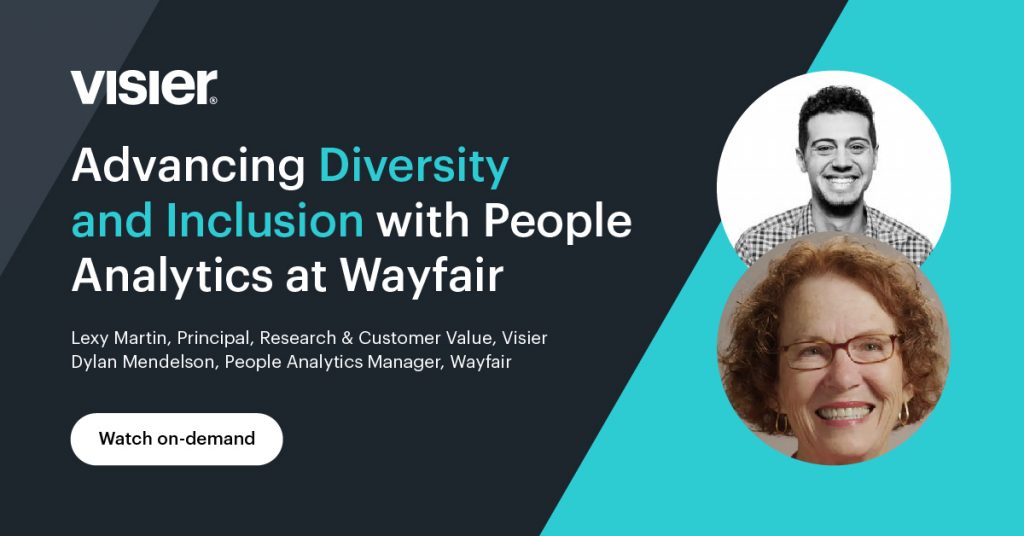How Wayfair Uses People Analytics to Improve DEI
Discover how Wayfair gathers actionable information with people analytics and uses it to improve their DEI initiatives.

By putting data in the hands of their leadership, Wayfair is improving their diversity, equity, and inclusion strategies.
E-commerce has grown into a multi-billion dollar industry with the home category alone expected to exceed $1 trillion by 2030 across North America and Western Europe. Wayfair has emerged as one of the largest online destinations for home with more than 31 million active customers. Founded in 2002, the e-commerce giant has grown into a global organization with over 16,000 employees worldwide.
The entire organization is driven by data and their Talent team is no exception. Wayfair’s people analytics team uncovers insights to maximize employee engagement and productivity and proliferates people data across the business to drive decision-making. This is accomplished through data collection, reporting, dashboarding, advanced analytics, and communication of insights.
“At Wayfair, we like to say that data is our thermostat,” says Dylan Mendelson, People Analytics Manager at Wayfair. “We value data transparency because we believe a well-informed team is better equipped to collaborate effectively toward our goals. We share people data and insights not only within our Talent team, but also with managers and leaders across the business to ensure everyone is accountable for building the best team.”
As the business has grown, they’ve put more focus on sustaining their employee experience at scale. Investing in diversity, equity, and inclusion plays a key role in helping the organization support their employees.
Taking action on DEI with data
To help scale Wayfair’s DEI Analytics function, the team partnered with Visier.
“For the first time, we could easily tell the full story around outcomes for underrepresented talent at every stage of the employee lifecycle, from hiring through exit,” explains Dylan. “This was crucial to understanding what the problems were, why they existed, and how to solve them.”
In fact, Wayfair now uses DEI data to ensure inclusivity is embedded in all of their people practices. Their analytics help identify opportunities to create a more diverse workforce, ensure equitable people processes (e.g., recruiting, performance reviews, compensation), and help leaders and managers steward an inclusive culture that fosters a sense of belonging and retains their people.
“We perform advanced statistical analyses to assess equity in all of our people practices,” says Dylan. “If we discover any potential inequities, we immediately flag them to leaders so they are able to course correct.”
Additionally, Wayfair collects and analyzes data not just on gender and race but on over 20 different diversity dimensions to ensure they are driving inclusion for all groups. This includes looking at data not just from US employees but from all employees across the globe. The team also leverages rich qualitative data. They apply natural language processing to detect biased language in interview feedback and performance reviews, and flag language to look out for to all managers.
Putting actionable insights in the hands of people leaders
Driving change in all of these areas requires an all-hands-on-deck approach, and sharing the data broadly has been critical to generating buy-in.
“Visier allows us to give leaders a holistic view of their data that empowers them to take action,” says Dylan. “We share data to show leaders their opportunity areas, and alongside the data, share toolkits with specific actions they can take to make improvements. Visier’s data journalism capabilities enable us to pair the data with action plans, which is critical for driving real change.”
Rolling out people analytics to leaders across the entire business has made a significant impact.
“Leaders across the business now understand their opportunities areas, set goals for improvement, and can track their progress over time,” explains Dylan. “We’re starting to see meaningful change thanks in large part to the level of insight and transparency we have been able to provide.”

Continue learning about improving DEI within your organization:
Get Outsmart content straight to your inbox
Subscribe to the People Insights Monthly newsletter for actionable insights and stories.
Subscribe now